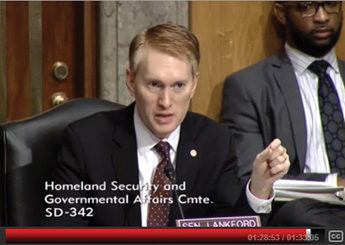Compliance assistance – not fines – should be priority, senators tell OSHA

Photo: Senate Homeland Security and Governmental Affairs Committee
Washington – While expressing concern about OSHA’s enforcement philosophy during a Feb. 11 hearing with the Senate Homeland Security and Governmental Affairs Committee, Sen. James Lankford (R-OK) offered an anecdote about his family.
Lankford’s teen daughter was driving and – unbeknownst to her – one of the vehicle’s headlights was out. A police officer stopped her. Rather than writing a ticket, the officer informed Lankford’s daughter about the problem, issued a warning and told her to fix the headlight as soon as she could.
“She got a warning,” Lankford explained to OSHA Deputy Assistant Secretary Jordan Barab at the hearing. “We fixed it. The health and safety issue of getting both headlights working was accomplished.
“What I’m trying to figure out is … how much flexibility do you feel like you have to help people, to say, ‘You missed one,’ and it’s not necessarily a fine?”
Barab explained that the agency separates its enforcement into serious violations, other-than-serious violations and a “quick fix” category in which employers can respond fast to minimize or sometimes eliminate the fine.
“There are certainly small things that we correct as we walk around, or that we ask the employers to correct – there’s no doubt about that,” Barab said. “But our concern is saving lives. … In general, our law requires us to issue a fine if we find a violation, especially if it’s a serious violation.”
Barab’s exchange with the committee was part of a lengthy hearing titled, “Examining Agency Discretion in Setting and Enforcing Regulatory Fines and Penalties.” Senators also heard testimony from Susan Shinkman, director of the Office of Civil Enforcement for the Environmental Protection Agency.
During the hearing, senators told Barab they had heard from employers carrying negative perceptions of OSHA. Penalties should be a last resort, senators said, with compliance assistance being the primary goal.
“Let’s not get out there with the ‘gotcha,’” said Sen. Heidi Heitkamp (D-ND). “Let’s get out there and invest a lot of resources in meeting compliance on the front end. The other thing that will be a bonus as a result of this is that you’ll begin to understand how some of your regulations are perceived and that they don’t add value to safety in the workforce. Those are regulations that have been written in Washington, DC … (and) when they’re applied, they don’t necessarily achieve a result that in any way adds value to workplace safety.”
Lankford asked Barab what could be done to encourage more businesses to invite safety regulators onsite to give advice and help rather than issue penalties.
Barab said OSHA dedicates about $68 million in its budget to federal compliance assistance. In addition, about $57 million is included in the consultation budget for small-business employers. OSHA funds about 90 percent of the consultation program, Barab said, and that money goes to states to run the program.
“I often call our consultation program our best-kept secret,” Barab said. “It’s totally separate from OSHA, and that’s what we try to emphasize to employers. It’s a free visit, basically, that small employers can receive, and everybody should take advantage of it.”
Lankford agreed. He said more employers should know about the program and understand that it is a neutral, effective approach to promote health and safety.
“We’d love to work with you on ways to do that,” Barab said. “There are a lot of myths out there that we would love to be able to combat.”
Post a comment to this article
Safety+Health welcomes comments that promote respectful dialogue. Please stay on topic. Comments that contain personal attacks, profanity or abusive language – or those aggressively promoting products or services – will be removed. We reserve the right to determine which comments violate our comment policy. (Anonymous comments are welcome; merely skip the “name” field in the comment box. An email address is required but will not be included with your comment.)

